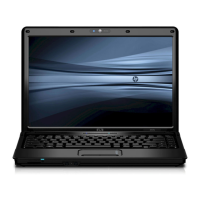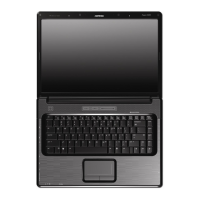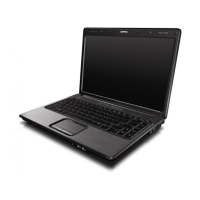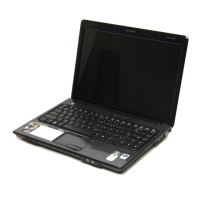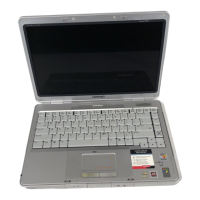
Do you have a question about the Compaq Presario V2000 - Notebook PC and is the answer not in the manual?
| RAM | 256 MB to 2 GB DDR SDRAM |
|---|---|
| Storage | 40 GB to 100 GB HDD |
| Battery | 6-cell Lithium-Ion |
| Processor | Intel Pentium M or Intel Celeron M |
| Graphics | Intel Graphics Media Accelerator 900 |
| Operating System | Windows XP Home or Windows XP Professional |
| Optical Drive | DVD±RW |
| Wireless | 802.11b/g |
| Networking | 10/100 Ethernet LAN |
| Ports | 3 x USB 2.0, VGA, RJ-45, headphone, microphone |
| Display | 14.1 inch WXGA (1280 x 768) |
Lists the necessary hardware components for initial notebook setup, including AC adapter, power cord, and battery pack.
Provides step-by-step instructions for correctly inserting the notebook's battery pack.
Guides on connecting the notebook's modem to an analog telephone line or other network connections.
Details the process of connecting the notebook to an AC outlet using the power adapter and cord.
Explains how to safely open the notebook display using the release button.
Instructs on pressing the power button to start the notebook and begin software setup.
Introduces the initial Welcome to Windows screen and basic navigation within the setup process.
Guides users through setting regional preferences for dates, currency, and time zones.
Details the process of accepting the End User License Agreement and HP Software Product License.
Explains how to assign a unique name to the notebook for network identification.
Provides instructions for registering the notebook and operating system with Hewlett-Packard.
Guides on creating individual user accounts for personalized notebook environments.
Details the final steps of software setup, saving preferences, and restarting the notebook.
Explains how to enable or disable the TouchPad tapping feature for single or double clicks.
Outlines various security measures to protect the notebook, including virus protection and system files.
Details how to protect the notebook from computer viruses using preinstalled antivirus software.
Explains the use of System Restore to undo harmful changes and protect system files.
Provides guidance on optimizing privacy protection features and using a firewall.
Offers advice on protecting the notebook from power surges and electrical storms.
Covers important safety precautions for using the notebook, including electrical safety and avoiding overheating.
Instructs on the correct procedures for shutting down the notebook using Windows or alternative methods.
Identifies and describes the function of various keys on the notebook keyboard, including Fn and Function keys.
Details the TouchPad components, including the touchpad itself, buttons, and scrolling regions.
Explains the function of the display switch and the power button for controlling the notebook's power states.
Describes the various indicator lights on the notebook, such as Caps Lock, Num Lock, and power status.
Details the wireless function button and volume control buttons on the notebook.
Explains the function of wireless antennae and provides safety information regarding RF exposure.
Illustrates and describes the indicator lights located on the front of the notebook.
Identifies the stereo speakers, audio jacks, and the display release button on the notebook.
Details the components located on the rear of the notebook, such as exhaust vents and the power connector.
Describes the ports and jacks found on the left side of the notebook, including monitor, expansion, network, and USB ports.
Explains the functionality of the PC Card slot and the eject button for inserting and removing PC Cards.
Details the notebook's vents for cooling and the security cable slot for physical protection.
Identifies components on the right side, including USB ports, 1394 port, memory reader, optical drive, and S-Video jack.
Describes the Mini PCI compartment for wireless LAN devices and the memory compartments.
Details the battery bay, release latch, exhaust vents, and hard drive bay on the bottom of the notebook.
Lists standard external hardware components like AC adapter, power cord, battery pack, and modem cable.
Explains the software and recovery discs included with the notebook, such as the Help and Support Guide.
Describes various labels on the notebook providing information like Service Tag, Product Key, and regulatory details.




